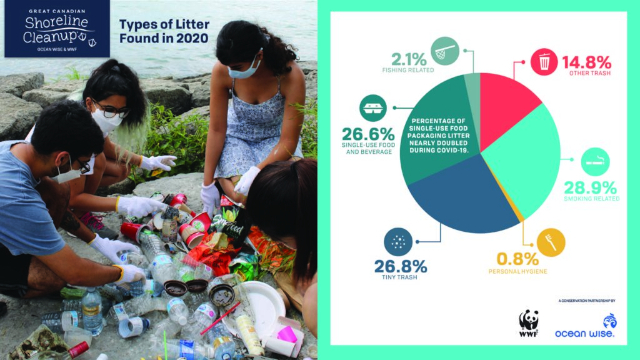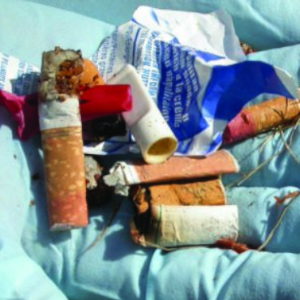If you thought your world changed in major, noticeable ways during the height (the pre-vaccine period) of the COVID-19 ‘era’, you may be surprised to discover that it also changed markedly in small, less-regarded ways. Right down to the crap we mindlessly throw away every day…
 Single-use food and beverage packaging litter increased by almost 70 percent in 2020.
Single-use food and beverage packaging litter increased by almost 70 percent in 2020.
Thanks to changes in food sourcing and eating habits triggered by the pandemic?
Junk Food consumption has soared, and drinking is up significantly since the pandemic was declared about 15 months ago. And now, analysis of litter collected by the Great Canadian Shoreline Cleanup (GCSC) (a conservation partnership of Ocean Wise and World Wildlife Fund Canada) show smoking has also increased. But the main culprit tainting our precious waters has become… Single use food packaging litter.
Triggered by a change in eating habits?
“We were startled to see that single-use food and beverage litter increased from 15.3 per cent of all litter in 2019 to 26.6 per cent in 2020,” says Julia Wakeling, outreach specialist for the GCSC. “We suspect the change may be one of the many implications of COVID-19, including more people ordering restaurant takeaway and consuming more individually packaged foods.”
Well, that makes perfect sense. But I would have thought the increase in pick-up and delivery dining would have triggered an even bigger increase in the amount of garbage people were putting out at the curb each week. Anybody have numbers on that metric?
Plastic still the prime culprit
“Pollution, especially plastic pollution, is one of the greatest threats facing our ocean, but it is a threat we can tackle together. We all have a part to play” adds Lasse Gustavsson, president and CEO of Ocean Wise. “Plastic has become omnipresent in our daily lives and yet each decision we make at work, at home, at school or out and about, has the potential to have a positive impact.”
“Fish, birds, turtles and other wildlife can mistake litter and plastic for food or become entangled,” says Megan Leslie, WWF-Canada’s president and CEO. “Every piece of garbage we remove from our freshwater and marine shorelines is one less piece that can harm wildlife. We are so grateful to all of our Shoreline Cleanup volunteers for their efforts to protect wildlife habitat and hope all Canadians will join us this year in taking action to help nature thrive.”
Vendors making inroads on biodegradables and recyclables
Fast Food vendors who disp0ense single-use food and beverage packaging items are making inroads in developing new recyclable and biodegradable packaging in partnership with a fast-growing environmentally-conscious materials engineering industry. But it appears they’re not progressing fast enough. Nevertheless, major Fast Food purveyors such as McDonald’s have made heroic commitments to sharply reduce or eliminate conventional plastic waste over the next few years; most by 2025.
We’ll see.
Meanwhile…
According to a recent WWF news release, “For the first time in Shoreline Cleanup’s 27-year history, volunteers reported finding masks and other personal protective equipment (PPE) on their cleanups. ‘We didn’t have a category on our data cards last year to formally track the amount of PPE-related litter volunteers were finding, but we have added one for 2021,’ adds Wakeling. ‘This year’s results will be very interesting’.”
That doesn’t surprise me at all. And with predictions from many directions that many folks will continue to use masks (just in case) when out in public, even after the pandemic is officially declared over, I fear the situation will become chronic, if not worse.
Now, if someone could come up with a biodegradable, or at least fully-recyclable, material for masks and other PPE items, we’d be flying…
~ Maggie J.

